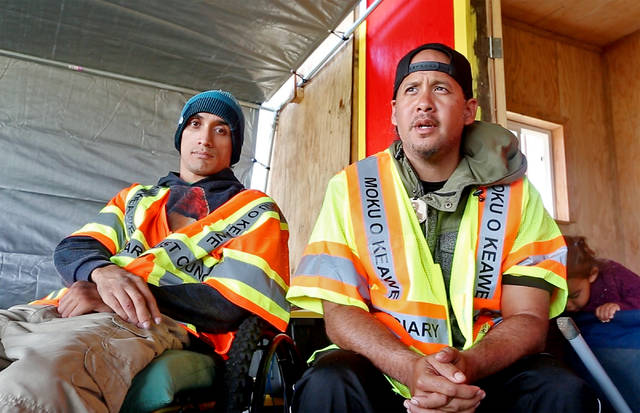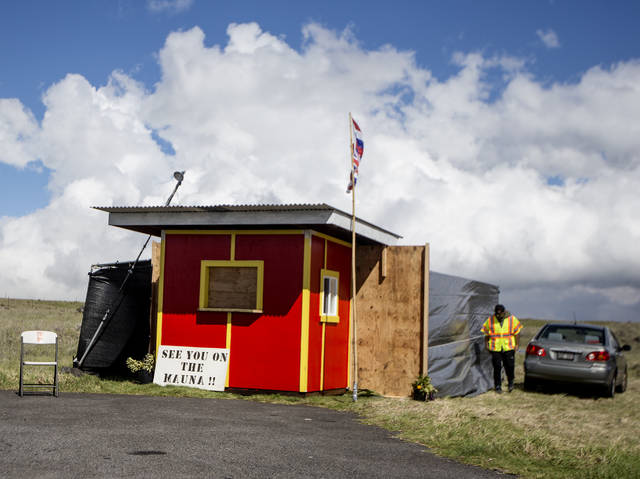The head of the Department of Hawaiian Home Lands said a group that started an “Aloha Safety Checkpoint” on beneficiary lands along the Maunakea Access Road this week did so without permission.
But she wouldn’t say when they will be told to leave.
“I prefer to take it one day at a time at this point,” DHHL Chairwoman Jobie Masagatani said Thursday. “We’re looking at our options. I’m not at liberty to discuss much more than that.”
A group called the Beneficiaries Trust Council started the checkpoint, which includes a small shack called “Hale o Kuhio” next to the road, on Monday’s Prince Kuhio Day. The road goes through DHHL land.
The group isn’t affiliated with DHHL, Masagatani said, but members say they advocate for beneficiaries on the agency’s lengthy homestead waiting list.
The group says it is up there to keep track of traffic on the road used to access Maunakea and Mana Road, which also passes through the department’s lands in the area, as part of resource management. By Wednesday, they were using a “slow” sign instead of a stop sign, and it wasn’t clear if they were still trying to get vehicles to stop at the checkpoint or just counting them as they pass.
There haven’t been reports of them blocking the road or telling people to leave, though some are staying overnight.
“Our dedication of Hale o Kuhio as an Aloha Safety Checkpoint is the first phase of community-led Malama Aina programming by our beneficiaries to maintain a presence and better manage roughly one-third of the total DHHL lands, some of the most important and critical cultural and natural resources in the Hawaiian Islands,” the group said in a press release.
That part of the road is maintained by Hawaii County. Hawaii Police Department Capt. Gregory Esteban said officers have been in contact with the group.
“If a violation is observed a warning will be issued,” he said. Esteban said Wednesday no warnings had been given.
Doug Arnott, who operates tours on Maunakea, said Wednesday the checkpoint hasn’t been an issue for his drivers.
“I just tell my drivers give them a smile and a shaka and slow down for them and say hi,” he said.
Masagatani said DHHL didn’t see it coming. Asked if she was surprised, she said, “Yes, in the sense their decision to occupy was made unilaterally. I think they did let people know but as it was happening.”
But what surprised her the most was that members of the group are already actively involved in discussions surrounding the trust holdings around Maunakea, known as ‘Aina Mauna, through an advisory committee. That committee is addressing issues such as managing vehicle access on Mana Road, invasive species and homesteading, she said, and has met twice since forming late last year, including a few weeks ago.
“They short-circuited the process,” Masagatani said. “What that does is complicate the discussion.”
She said Kepa Kaeo, who helped organize the checkpoint, sits on the advisory committee and has brought good mana‘o (thought) to the process.
Attempts to reach Kaeo for comment were unsuccessful Thursday.
He told a Tribune-Herald photographer Wednesday that they are trying to bring attention to the more than 22,000 Hawaiians on the DHHL waiting list and the limited number of pastoral leases issued. He said he didn’t want to blame any agency or person but thinks the state has failed to fulfill the purpose of the Hawaiian Homes Commission Act, which Congress passed in 1921.
The ‘Aina Mauna lands consist of 49,100 acres from the Daniel K. Inouye Highway and hugs Maunakea along Mana Road. DHHL completed an ‘Aina Mauna Legacy Program in 2009. More than 4,500 acres has been designated for homesteads, while much of the rest is identified for pasture or forestry uses.
BTC members say they want to get beneficiaries on the land sooner than later. In their statement, the group says the checkpoint is the next step in its “Aina Mauna Solution.”
But they also say they want to work with DHHL.
“We’re providing numerous amounts of volunteer hours they are not able to do,” said Kalaniakea Wilson, one of BTC’s “kanaka rangers.” He said they will pass along the vehicle counts to the department.
Nearly all the traffic on the road is headed up Maunakea. The University of Hawaii tracks vehicles near the visitor information station.
Others share their frustration in delays in getting people on the land, even if they disagree with their tactics.
“There are so many meetings,” said Wally Ishibashi, who represents East Hawaii on the Hawaiian Home Lands Commission. “We are just meeting to meet again about the meetings we had before.”
Masagatani said she anticipates the ‘Aina Mauna advisory group, which includes a representative from each of the homestead associations on the island, will continue to meet.
She said issuing homestead leases is challenging in the area because it has no infrastructure.
There also are questions about how big the lots should be and whether communal use of the land through ranching is appropriate.
“We’re trying to work collaboratively with our beneficiaries,” Masagatani said. “As you can imagine, our beneficiaries are not a homogeneous group.”
Email Tom Callis at tcallis@hawaiitribune-herald.com.










Infrastructure? For millenia the Hawaiians lived off this land, up to a million lived on Big Island, without Matson or HELLCo.
DHHL has forced infrastructure be installed in Makuu and Kalapana Reservations, but the Hawaiians cant afford it so the land sits unused and families die waiting for land.
And any land “owned” by the State BELONGS TO THE PEOPLE NOT THE GOVERNMENT.
The ugly face of racists in collusion with the foolish demo rats divisive and racist agenda promotes the break down of law and order as the racists want. It is called civil war and the demo rats are fanning the flames of death and destruction.
“up to a million lived on Big Island” false Sara!
“DHHL has forced infrastructure be installed in Makuu and Kalapana” Everyone else must have proper sewage and pay for it. NO cesspools on Mauna Kea.
Point One: These activists don’t know that Prince Kuhio was a
Republican in favor of annexation, and then spoke in favor of full
Statehood his entire career. Yet, the 2/3rds majority Polynesian voting
block at the time (Japanese, Chinese, Portuguese, and other immigrants
where not allowed to vote unless born here) repeatedly elected him to
be Delegate to the U.S. Congress until his tragic death by a heart
attack in 1922. If the Polynesians were so against being part of the
U.S. why would they have continued to vote for someone that was?
Point two: The land does NOT belong to them. That land is owned by the State to be used for the “Rehabilitation Experiment” (as it was called at the time) to “save a dying race”. The entire experiment has been a dismal
failure and should be eliminated on so many grounds.
Their race is NOT dying, in fact it is the fastest growing race in the U.S., it is discriminating to all other races (before 1920 all races could homestead
the land), and the whole program has morphed into a buy Tutu a condo in
Kona program, not a farming program as originally intended.
The farmlots that are leased are mostly doing little or no farming, with
illegal structures everywhere, people living on them that shouldn’t be,
and a whole host of nefarious activities going on. The program has
resisted any audit, but it did admit a few years back that the loan
program was over $100,000,000 (one hundred million dollars) in arrears
from non-performing contracts. In short, a complete mess. It has now
become a black hole where tax payer’s money goes in and never comes out,instead of the self supporting program it was intended to be. Race
based fraud on the rest of the citizenry is what it has become.
Report: U.S. Department of Commerce
Economics and Statistics Administration
U.S. CENSUS BUREAU
Issued May 2012
C2010BR-12
The Native Hawaiian and Other
Pacific Islander Population: 2010
2010 Census Briefs
By Lindsay Hixson,
Bradford B. Hepler,
and Myoung Ouk Kim
INTRODUCTION
According to the 2010 Census,
1.2 million people in the United
States identified as Native Hawaiian
and Other Pacific Islander, either
alone or in combination with one
or more other races. The Native
Hawaiian and Other Pacific Islander
population was the race group most
likely to report multiple races in
2010, as more than half (56 percent)
reported multiple races. The Native
Hawaiian and Other Pacific Islander
population was one of the fastest-
growing race groups between 2000
and 2010.
Kudos for your comments, diverdave.
Alas, it will fall on deaf ears.
Granted DHHL does have their issues, it’s not the Hawaiian’s, it’s the idiots like Jobie who heads the organization, that completely messes things up. Oh, Dave, you sound like all of the other angry haole’s who want to take instead of give. You probably have no connection to the land, therefore, like a good majority of the haole’s, could care less and all you do is complain, complain, COMPLAIN!!!
I’m sorry that you see things in color. I do not.
There was once a King that had the same name. He led to the downfall of the Monarchy model government here.